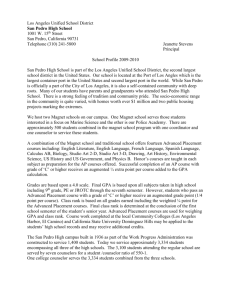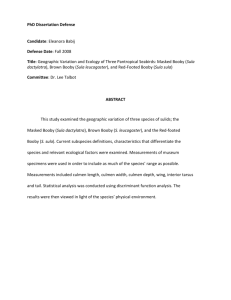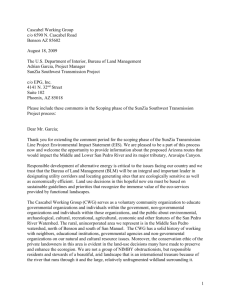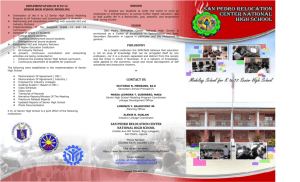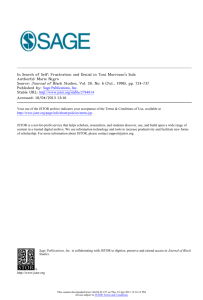Quasi-Economic Political Units in Latin America
advertisement
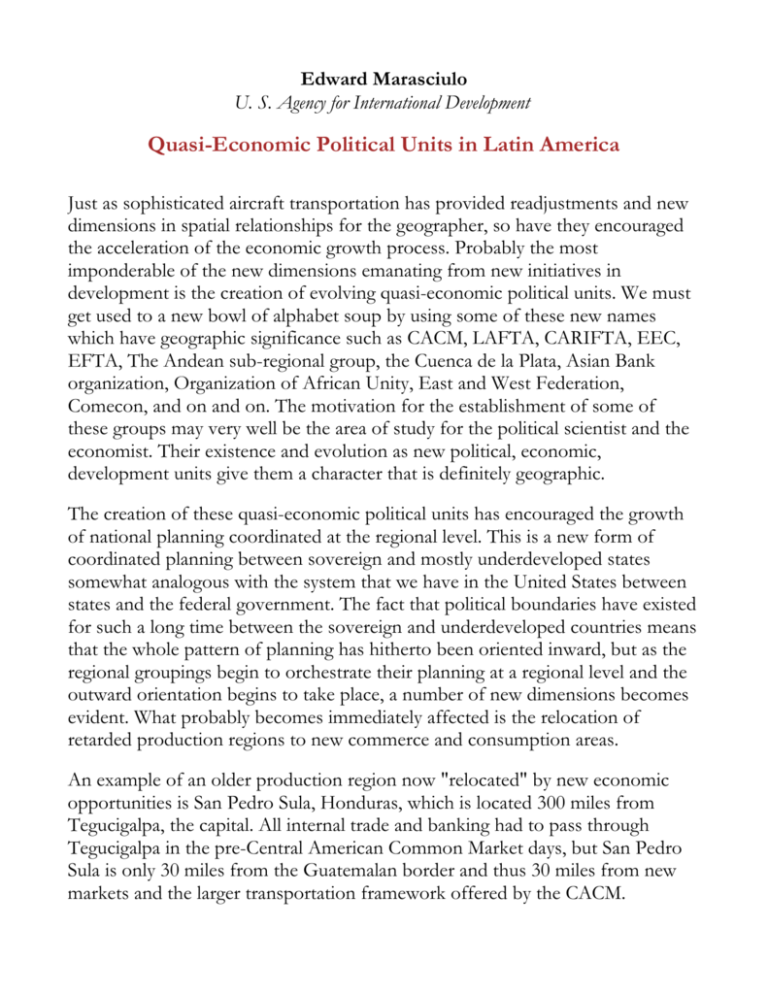
Edward Marasciulo U. S. Agency for International Development Quasi-Economic Political Units in Latin America Just as sophisticated aircraft transportation has provided readjustments and new dimensions in spatial relationships for the geographer, so have they encouraged the acceleration of the economic growth process. Probably the most imponderable of the new dimensions emanating from new initiatives in development is the creation of evolving quasi-economic political units. We must get used to a new bowl of alphabet soup by using some of these new names which have geographic significance such as CACM, LAFTA, CARIFTA, EEC, EFTA, The Andean sub-regional group, the Cuenca de la Plata, Asian Bank organization, Organization of African Unity, East and West Federation, Comecon, and on and on. The motivation for the establishment of some of these groups may very well be the area of study for the political scientist and the economist. Their existence and evolution as new political, economic, development units give them a character that is definitely geographic. The creation of these quasi-economic political units has encouraged the growth of national planning coordinated at the regional level. This is a new form of coordinated planning between sovereign and mostly underdeveloped states somewhat analogous with the system that we have in the United States between states and the federal government. The fact that political boundaries have existed for such a long time between the sovereign and underdeveloped countries means that the whole pattern of planning has hitherto been oriented inward, but as the regional groupings begin to orchestrate their planning at a regional level and the outward orientation begins to take place, a number of new dimensions becomes evident. What probably becomes immediately affected is the relocation of retarded production regions to new commerce and consumption areas. An example of an older production region now "relocated" by new economic opportunities is San Pedro Sula, Honduras, which is located 300 miles from Tegucigalpa, the capital. All internal trade and banking had to pass through Tegucigalpa in the pre-Central American Common Market days, but San Pedro Sula is only 30 miles from the Guatemalan border and thus 30 miles from new markets and the larger transportation framework offered by the CACM. Therefore we must give San Pedro Sula a different growth quotient in the preCommon Market and the post-Common Market era, San Pedro Sula's location within a Central America that is a single economic unit and trading area, and without the historic constraints to growth that it had within its sovereign state status, gives it by far a much greater comparative advantage to growth than the capital city. Lifting these constraints also gives San Pedro Sula the attainable goal of becoming the major eastern city in Central America, a region which has been historically west coast oriented. Obviously the unfortunate mini-war in Central America will readjust an otherwise perfect model, but this should not minimize the fact that there will be many new and dynamic production centers like San Pedro Sula that will be evolving as a result of the changing factors of location as some restrictive political boundaries give way to larger regional units. Political problems aside, we do have an opportunity and an obligation to give our young geographers insight into these new economic units. It may very well be that area specialists have a comprehensive idea of what is happening in the various integration movements, but with candor I think we can agree that there is a good deal that the academic community does not know about these regional units because we lack adequate detailed research. For example, the integration Research Institute in Buenos Aires has recently published a large volume on regional projects within the area of the Cuenca de la Plata. The multinational projects center around the geographic units (or should I say the geographic barriers), the Parana and Paraguay rivers. Some of these projects are already being implemented and certainly most of them will get under way during the 1970's. Should we not analyze these projects in both a macro and micro sense and ask what effect they will have on the changing landscape of the underdeveloped heartland of South America? For example, the tunnel under the Parana River connecting Santa Fe and Parana in Argentina was opened in January of 1970. The traffic count for the past three months is twice that predicted by the transportation engineers. Last month the Argentines and Uruguayans agreed to construct the bridge over the Uruguay river connecting Colon, Argentina with Paysandu, Uruguay. When the bridge is constructed, a new transcontinental route will be opened connecting Uruguay and Southern Brazil with a route that traverses an east-west axis across Argentina to Santiago, Chile. This new route will compete with the classic radial transportation pattern out of Buenos Aires that we have all emphasized in Latin America courses. There are other new regional dimensions in South and Central America which should be field researched. Perhaps we should not limit our geographic research to the landscape "as it is" but also "how it will be". Certainly this is a caveat we should ponder if geography is in any way related to planning. During the 1970's the forces toward developing multinational river basins and frontier areas in Latin America will no doubt increase as the countries begin to focus more on integration and economic development. The very fact that rivers have been used as international boundaries has inhibited the harnessing of rivers for hydro-electric power and transportation, but in Latin America, where manmade borders often do not correspond to physical features, river basins, and especially larger ones, have been divided and drain more than one country's territory. Developing such basins will require new initiatives in cooperative action and most likely will require special international agreements and international planning. The development of multinational river basins can provide electrical energy, raw materials for industry, navigation, and flood control. An important result of planning could be increased agricultural production which would decrease or eliminate present import requirements and provide surplus produce for export abroad. Perhaps even more important, the development of such river basins can improve the standard of living of the rural community which is still the home of a majority of the Latin American people. In addition to those direct benefits, multinational river basin developments can lead to long-term indirect benefits such as the following, assuming, of course, concurrent investments in infrastructure: 1. Decentralization of industry due to availability of cheap power and availability of raw materials such as pulp wood, raw fibers, surplus foodstuffs for processing. 2. New and revitalized urban communities and education. 3. Local trade with a neighboring country or countries. 4. Social and cultural contacts among adjoining countries. 5. Eventual opening up of vast areas heretofore considered practically inaccessible, ultimately including the great Amazon Basin. In most cases, the initial impacts of multinational river basin developments would be in the sectors of improved agricultural production, power generation, penetration roads and possible small food-processing and fibre plants. All these developments are subject to geographic analysis.
